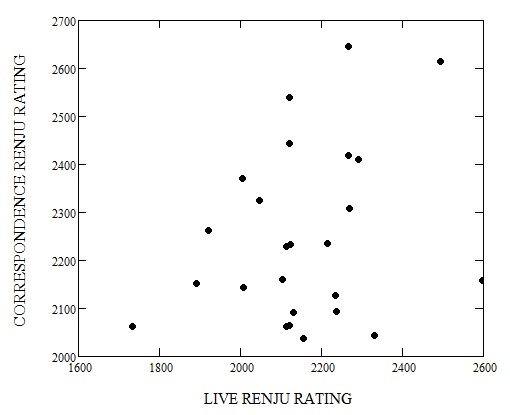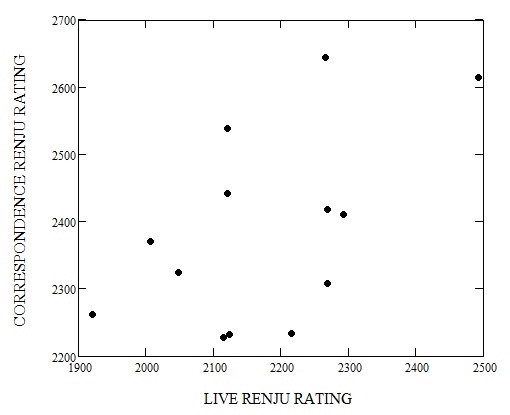Is there a correlation between the levels of play in live and correspondence gomoku&renju? Being a five games fan and a scientist (physicist), Sandra Jones decided to mathematically analyse the available statistics to find out the answer.
Here is what she writes:
With the first ever world correspondence gomoku championship having started only this season, there are almost no statistics for correspondence gomoku, but there are a lot of statistics for correspondence games in renju, a game very similar to gomoku. In renju, the world correspondence championship has been being held since decades ago, and there is a very long correspondence renju rating list containing 440 players.
So I decided to analyse the correspondence and live renju ratings to see whether there is any correlation.
Of course, I did not blindly take all data from those rating lists. Being a scientist, I first thought about setting exclusion criteria in order to avoid systematic errors.
The first potential source of systematic error is that it is not equally difficult to earn live rating points in different countries. Dmitry Epifanov, a prominent Russian renju player, made some posts on the Russian gomoku discussion forum about that issue. European and Asian renju countries are practically isolated from each other in terms of live renju tournaments, facing each other practically only in the world championship and world team championship. As a result, different countries have, in effect, their own rating scales, so to speak, i.e., one and the same level of play corresponds to different ratings in different countries. Shigeru Nakamura, whose live rating was 2756 before the last world championship, finished there behind Vladimir Sushkov, Jianfeng Zhu, and Shu-Hsuan Lin, whose live ratings before the championship were 2507, 2485, and 2512, respectively.
For this reason, I decided to use only data for Russian players, excluding all other nationals in order to ensure using the same live rating scale for everyone. I chose Russia because it is by far the leading power in correspondence renju: In the last decade, 9 different Russians won 14 medals of the world correspondence championship, with 4 of those medals being gold, while the second power in correspondence renju, China, won only 3 medals, whereof only 2 are gold.
The second potential source of systematic error is that in live renju, one and the same level of play corresponds to different ratings nowadays and many years ago. In other words, the live rating scale changes with time, so it would be misleading to compare the live rating of a player who stopped playing a decade or a couple of decades ago with the current live rating of an active player. The world was simply very different at that time. For example, Konstantin Nikonov had a rating of 2471 in 2005 and now has a rating of 2269. Irina Metreveli had a rating of 2239 in 2004 and now has a rating of 1893, about 350 points below her old rating.
To avoid this systematic error, I decided to take only those players who are on the live rating list of active established players (http://renjuoffline.com/renju-rating). The list shows only those established players whose last live performance dates back to no more than five years ago.
With the exclusion criteria outlined above and only looking at the first 200 lines of the correspondence rating list, I got 27 players who have both a live rating and a correspondence rating. I did not look further than the first 200 lines, because I wanted to exclude amateurs and those who did not take correspondence renju seriously.
Looking at those 27 players, I decided to exclude two of them, namely Ekaterina Glibina and Viktor Barykin. Ekaterina Glibina has a very odd live rating (1321) and may have been helped by others in her correspondence games, especially as the live rating list contains Alexey Glibin, apparently her relative. Viktor Barykin was invited to play in the Russian High League this year just a couple of days before the start and did not prepare at all, which resulted in an utter failure (16th place out of 16 participants, with 2.5 points in 15 rounds). In his previous Russian High League (2013) he finished in the middle of the table despite skipping two rounds for travel issues and, in particular, achieved draws against the gold and silver medal winners. He won the world correspondence championship in 2005, more than a decade ago, and apparently stopped playing correspondence renju in that epoch. It would be very misleading to take his correspondence rating earned more than a decade ago together with his current live rating. Viktor’s highest live rating (2331) is comparable to that of Nikonov (2471), who won the Russian renju championship twice.
Here are the data for the remaining 25 players:
Correspondence rating | Live rating | Player
2644 2267 Epifanov Dmitriy
2614 2494 Sushkov Vladimir
2538 2121 Potapov Aleksey
2442 2121 Golosov Victor
2418 2269 Nikonov Konstantin
2410 2293 Tarannikov Yuriy
2370 2007 Balabhai Viktor
2324 2049 Filinov Vladimir
2308 2270 Fedorkin Oleg
2262 1922 Volkov Sergey
2234 2216 Makarov Pavel
2232 2124 Mikhailov Alexey
2228 2115 Artemyev Sergey
2160 2106 Berezin Roman
2157 2598 Chingin Konstantin
2151 1893 Metreveli Irina
2142 2008 Danilin Ivan
2126 2235 Karasyov Maxim
2092 2238 Kareev Vlad
2090 2132 Vershinin Pavel
2064 2123 Serdiukov Egor
2062 1735 Salnikova Nonna
2061 2115 Artemiev Sergey
2042 2331 Kozhin Mikhail
2036 2157 Salnikov Pavel
Here is how these data look in a graph:

I calculated the Pearson correlation coefficient, and it turned out to be equal to 0.27. That is, the correlation is 27%.
The actual correlation between the live and correspondence levels must be even stronger, because a number of players in the above statistics (e.g., Roman Berezin and Mikhail Kozhin) failed to finish many games in their last correspondence championships, which resulted in automatic losses and big negative changes of the ratings. The resulting ratings of such players do not reflect the actual correspondence level of play and thus worsen the correlation.
Taking only those players who are above Berezin on the above list, i.e., the first 13 players, I got the following graph:

For these 13 players, i.e., for the top 13 correspondence players on the list above, the Pearson correlation coefficient is 0.54, i.e., the correlation is as strong as 54%! The correlation is so strong that it can be easily seen in the graph by the naked eye.
The conclusion is simple: There is a substantial correlation between the level of play in correspondence renju and the level of play in live renju.
And this conclusion helps dispel the popular myth that correspondence games are a mindless sport wherein players simply copy moves from programs. People who believe in this myth know nothing about correspondence games. Correspondence games are battles of strategists. What decides in this sport is strategic planning, the ability to focus on important branches, systematic thinking, skills of computer analysis, and deep understanding of the game. Correspondence games are devoid of tactical blunders, so you cannot trick your opponent by setting a simple tactical trap as you do in live tournaments. Correspondence games are a sport for those who have a great passion for analysis and appreciate the deep beauty of the game.


